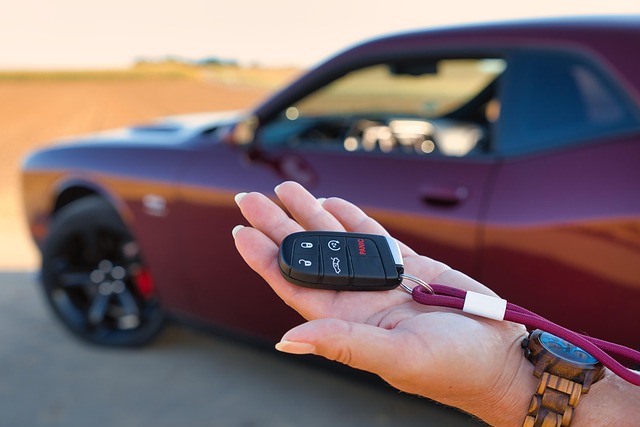Registering a car in California is a straightforward process, but it requires understanding specific requirements and gathering essential documents. This comprehensive guide walks you through every step, from preparing necessary papers to visiting your local DMV. We’ll also show you how to verify vehicle identity using the official DMV VIN checker and highlight the fees involved. By following these steps, you’ll have your car registered in no time, ensuring smooth sailing on California’s roads.
- Understand California Car Registration Requirements
- Gather Necessary Documents for Car Registration
- Visit Your Local DMV: Steps to Register a Vehicle
- Verify Vehicle Identity Using DMV's VIN Checker
- Pay Car Registration Fees and Receive Your License Plate
Understand California Car Registration Requirements

Before registering your car in California, it’s crucial to understand the state’s specific requirements. The California Department of Motor Vehicles (DMV) mandates that all vehicles operating within the state be properly registered and titled. This process involves verifying key information about your vehicle, including its unique Vehicle Identification Number (VIN). A reliable VIN verifier is essential for ensuring accuracy during registration.
Using a mobile VIN verifier or conducting a thorough vin inspection can help streamline this process significantly. These tools allow you to quickly gather crucial data linked to your car’s VIN, making it easier to complete the registration at a DMV office or even remotely. Remember, adhering to these requirements is not just about compliance; it also ensures that California’s roads are safe and well-maintained for all users.
Gather Necessary Documents for Car Registration

Before you start the registration process, it’s crucial to gather all the essential documents. In California, registering a car involves verifying your vehicle’s unique identifier, known as the Vehicle Identification Number (VIN). Use a DMV VIN verifier or conduct a mobile VIN inspection to ensure the VIN is accurate and matches the vehicle you’re registering. This includes bringing along the title or registration certificate from the previous owner, which displays the VIN.
Additionally, prepare other necessary paperwork such as proof of insurance, a completed application form (DMV Form REG-157), and a valid driver’s license. If you purchased the car from a dealership, they may provide you with additional documents related to the vehicle’s history and maintenance records, which can streamline the registration process. For those conducting a mobile VIN verification, ensure that all information aligns before proceeding with the registration at your local California DMV office.
Visit Your Local DMV: Steps to Register a Vehicle

Visiting your local DMV is a crucial step in the process of registering your car in California. Bring all necessary documents, including proof of ownership, vehicle identification number (VIN), and valid identification. The DMV will verify your VIN using advanced tools to ensure the vehicle’s history is clean and free from any legal issues or outstanding loans. This critical process helps protect both you and future buyers by ensuring the car is safe for registration.
Once your VIN has passed inspection, the DMV staff will guide you through the registration process, which involves filling out forms, paying fees, and providing additional information about the vehicle. They may also conduct a physical inspection of the car to ensure it meets safety standards. With a mobile VIN verifier, many of these steps can be streamlined, allowing for a more efficient and convenient registration experience in California.
Verify Vehicle Identity Using DMV's VIN Checker

Before registering your car in California, it’s crucial to ensure the vehicle’s identity is verified. One efficient way to do this is by utilizing the Department of Motor Vehicles (DMV) Vin Verifier tool. This online or mobile vin inspection service allows you to quickly cross-reference the Vehicle Identification Number (VIN) with the DMV’s records, confirming key details about the car’s history and specifications.
Using a simple VIN checker application accessible through the DMV’s website or as a mobile app, you can input your vehicle’s unique 17-character VIN and instantly gain valuable insights. This process not only helps in avoiding potential fraud but also ensures that you’re registering a safe and legal vehicle. It’s a straightforward step that makes the registration process smoother, especially when compared to traditional methods of gathering documents and conducting manual checks.
Pay Car Registration Fees and Receive Your License Plate

After submitting your application for car registration at the California DMV, the next step is to pay the corresponding fees. These fees vary based on the type of vehicle and its use. You can typically pay online, by mail, or in person at a DMV office. Once your payment is processed, you’ll receive a temporary registration permit and instructions for picking up your license plate.
To streamline this process, many Californians opt for a mobile vin verifier or mobile vin verification service to ensure their vehicle’s history is accurate before registration. This technology allows for quick and convenient mobile vin inspection, providing peace of mind and saving time at the DMV.
Registering a car in California is a straightforward process that requires understanding specific requirements and gathering essential documents. By following these steps, from visiting your local DMV to paying registration fees, you’ll be on your way to legally owning a vehicle in the Golden State. Don’t forget to utilize the DMV’s VIN checker for vehicle identity verification, a crucial step in ensuring compliance with California car registration laws.
